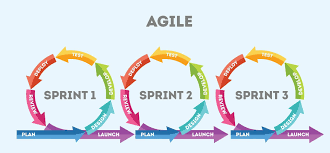Mastering Agile Software Development: A Guide to Efficient Project Delivery
The Advantages of Agile Software Development
Agile software development has gained popularity in recent years as a flexible and efficient approach to creating software. Unlike traditional waterfall methods, agile focuses on iterative development, collaboration, and customer feedback. Let’s explore some of the key advantages of agile software development.
Rapid Adaptation to Change
One of the main benefits of agile is its ability to adapt quickly to changing requirements. By breaking down the project into smaller increments or sprints, teams can easily incorporate new features or make adjustments based on feedback. This flexibility allows for a more responsive and dynamic development process.
Enhanced Collaboration
Agile promotes close collaboration between cross-functional teams, including developers, designers, and product owners. Through daily stand-up meetings and regular communication, team members can work together effectively towards a common goal. This collaborative environment fosters creativity, innovation, and a sense of ownership among team members.
Increased Customer Satisfaction
By involving customers in the development process through regular demos and feedback sessions, agile ensures that the final product meets their expectations. This customer-centric approach leads to higher satisfaction levels and reduces the risk of building features that are not valuable to users. Ultimately, agile helps deliver products that truly address customer needs.
Improved Quality
Agile emphasizes continuous testing and integration throughout the development cycle. This focus on quality assurance helps identify issues early on and ensures that the software meets high standards before deployment. By addressing bugs and defects promptly, agile teams can deliver a more reliable product with fewer errors.
Efficient Resource Management
With its iterative approach, agile allows teams to prioritize tasks based on their importance and value to the project. This enables efficient resource allocation and helps prevent delays caused by bottlenecks or dependencies. By focusing on delivering working software in short iterations, agile maximizes productivity and minimizes waste.
In conclusion, agile software development offers numerous benefits that contribute to faster delivery times, improved quality, enhanced collaboration, and greater customer satisfaction. By embracing agility in their processes, organizations can stay competitive in today’s fast-paced tech landscape.
6 Essential Tips for Effective Agile Software Development
- Embrace change and be flexible in responding to it.
- Collaborate closely with stakeholders and team members throughout the project.
- Deliver working software frequently, with a preference for shorter timescales.
- Focus on individuals and interactions over processes and tools.
- Maintain a sustainable pace by promoting a healthy work-life balance.
- Reflect on how to become more effective as a team and adjust accordingly.
Embrace change and be flexible in responding to it.
In agile software development, it is essential to embrace change and be flexible in responding to it. By welcoming changes in requirements, feedback, or priorities, teams can adapt quickly and deliver value more effectively. Being open to change allows for continuous improvement and innovation throughout the development process. Flexibility enables teams to respond promptly to new opportunities or challenges, ensuring that the final product meets the evolving needs of customers and stakeholders.
Collaborate closely with stakeholders and team members throughout the project.
Collaborating closely with stakeholders and team members throughout the project is essential in agile software development. By maintaining open communication and involving key individuals from the beginning to the end of the project, teams can ensure alignment on goals, priorities, and expectations. This collaborative approach fosters a shared understanding of requirements, promotes transparency, and enables timely feedback that can drive continuous improvement. Engaging stakeholders and team members in decision-making processes not only enhances the quality of the final product but also builds trust and strengthens relationships within the team.
Deliver working software frequently, with a preference for shorter timescales.
In agile software development, the practice of delivering working software frequently, with a preference for shorter timescales, is crucial for maintaining momentum and ensuring continuous progress. By breaking down the project into smaller iterations and focusing on delivering tangible results at regular intervals, teams can gather feedback early, address any issues promptly, and adapt to changing requirements more effectively. This iterative approach not only enhances transparency and collaboration but also allows stakeholders to see tangible outcomes sooner, leading to higher satisfaction levels and a more responsive development process.
Focus on individuals and interactions over processes and tools.
In agile software development, it is essential to prioritize individuals and interactions over processes and tools. By fostering effective communication and collaboration among team members, agile teams can better adapt to change, share knowledge, and work towards a common goal. While processes and tools are important, it is the people behind them who drive innovation, creativity, and problem-solving. Emphasizing individuals and interactions creates a dynamic and supportive environment where team members can thrive and deliver high-quality software efficiently.
Maintain a sustainable pace by promoting a healthy work-life balance.
In agile software development, it is crucial to maintain a sustainable pace by promoting a healthy work-life balance. By encouraging team members to prioritize their well-being and avoid burnout, organizations can ensure that productivity remains high and quality is not compromised. A balanced approach to work allows individuals to recharge, stay motivated, and bring fresh perspectives to the development process. Ultimately, fostering a culture that values both professional success and personal wellness leads to happier, more engaged team members and better outcomes for the project as a whole.
Reflect on how to become more effective as a team and adjust accordingly.
Reflecting on how to become more effective as a team and adjusting accordingly is a crucial aspect of agile software development. By regularly evaluating team dynamics, communication strategies, and workflow processes, teams can identify areas for improvement and make necessary adjustments to enhance their overall efficiency and productivity. This practice of self-assessment and adaptation not only fosters continuous growth and learning but also ensures that the team remains agile and responsive to changing project requirements and challenges.



